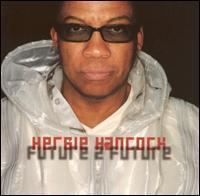Released 2001 Label Transparent Music | Recorded 2001 Release date 2001 | |
 | ||
Future2Future(2001) Directions in Music Live at Massey Hall(2002) Genres Jazz, Jazz fusion, Electronica Similar Herbie Hancock albums, Jazz albums | ||
Future 2 Future is the forty-third album by Herbie Hancock. Hancock reunited with bass player Bill Laswell (who worked on the influential early 1980s albumsFuture Shock, Sound-System and Perfect Machine) and the two of them tried to recapture the success of the three previous albums that fuse jazz with cutting-edge electronic music.
Contents
In yet another innovative stylistic move, Herbie reunited with Bill Laswell in the creation of a 21st Century collaboration with some of the young hip-hop and techno artists who have drawn on his massive influence to create their own music of the future. The album was released in spring, 2001, and is entitled FUTURE2FUTURE.
This group of artists (minus Tony Williams, due to his death four years prior) would go on tour, and produce a live concert that would eventually go on DVD (which features live versions of his songs "Rockit" and "Chameleon").
Content
Future2Future is the only album Hancock released on Transparent Music, a label he created in the late 90's with Chuck Mitchell (one time president of Verve Records) and David Passick (Hancock's manager). The main collaborative source is in Bill Laswell, who Hancock had worked with many times before, including the incredibly successful Future Shock (most known for the club hit "Rockit"). Future2Future is very different from previous efforts due to its attempt to delve further into electronica. Hancock keeps most of his playing relatively conservative, holding to chords and sweeps while Laswell has short grooves on the bass guitar. The more intricate sounds on each track are in the drum beats (whether played on a kit or electronically generated) and the use of turntables.
Tony Williams, a drummer Hancock had worked with multiple times throughout his career, is sampled on track 6 under softly spoken poetry by Dana Bryant.
An album of remixes was released to make some of the songs more pop accessible. After releasing the album the band took the tracks on tour, and a film of the tour's stop at the Knitting Factory in Hollywood was made.
Critical reception
The album met with mixed to positive reviews.
Track listing
- Kebero Part I - 3:10
- Wisdom - 0:33
- The Essence - 4:54
- This Is Rob Swift - 6:55
- Black Gravity - 5:29
- Tony Williams - 6:09
- Be Still - 5:12
- Ionosphere - 3:59
- Kebero Part II - 4:47
- Alphabeta - 5:29
- Virtual Hornets - 8:51
Personnel
Guest musicians
Songs
1Wisdom1:09
2Kebero3:27
3The Essence (feat Chaka Khan)4:48
